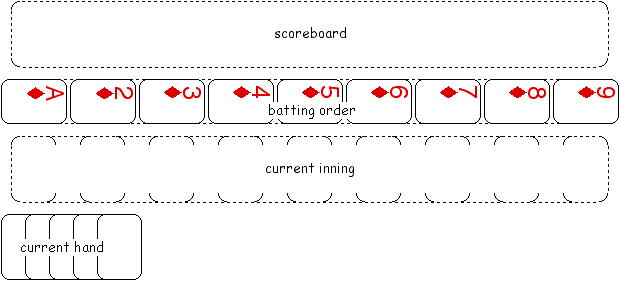Rules For Santa’s Baseball Solitaire
(Jul/7/2003)
This is a game of card solitaire using a double deck. The game roughly
models a one-sided (offense-only) game of baseball.
From a double deck of 104 cards, remove one set of ace thru 9 of diamonds to
use as lineup cards. Shuffle the remaining 95 cards.
Place the nine lineup cards in order, in a row, face up, sideways. You will
play cards for each batter below the corresponding lineup card. The area
above the lineup is the scoreboard. At the end of each inning you will put a
card in the scoreboard for each run scored during that inning.

You will make plays for one batter after another. A play consists of
- drawing enough cards so that you have five cards in your hand
- playing one to four cards for this batter
- advancing runners
Batting proceeds in the order of the lineup. In the first inning, the ace
bats first, then the 2, then the 3, and so on. After the number 9 batter, the
ace bats again, with 2 following, etc.. When an inning ends, batting picks up
at the next spot in the following inning. For example, if the number 7 batter
makes the third out, the next inning begins with the number 8 batter.
For a batter to get a hit, you must play card(s) that match his lineup
position. For example, for the number six batter you would have to play a
six. One six would be a single; two sixes would be a double; three would be
a triple; and four a home run. Instead of getting a hit, a batter may walk
if you play four face cards. The batter is out if any other card is played.
The cards for a batter are played below the lineup card. If the batter is
out, the card is placed face down. If the batter reaches base, the card(s)
are played face up in a stack, with the top card determining the runner's
suit. The stack then becomes a runner and can be advanced by a later batter.
The stack is angled to show what base the batter or runner is on. For
first base the card is slanted to the right; for second base straight up;
for third base slanted left; when a run scores the card is placed sideways.
All runners score when the batter hits a triple or home run. Runners normally
advance one base on a single and two on a double. If the runner's suit
matches the batter's suit, the runner can take an extra base. If a runner
advances from first to third on a single and another runner would have stopped
at third, that runner scores. On a walk, any runners forced to take the next
base do so; other runners stay put.
Runners do not normally advance on outs. A ten can be played as a sacrifice
bunt. If all runners match the suit of the ten, they advance. If any runners
don't match it, none advance.
The game is won if you score more than nine runs in nine innings. If you
score less than nine, you lose. If you only score nine, you must play extra
innings (winning if you score more than a run in some inning, losing if you
fail to score, and continuing if you just score once).
If the entire deck is used, the game is called due to rain. You win if you
have played at least five innings and have scored more runs than innings
played.
Example Game




